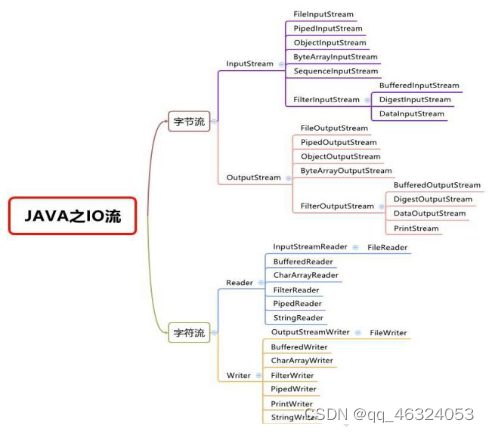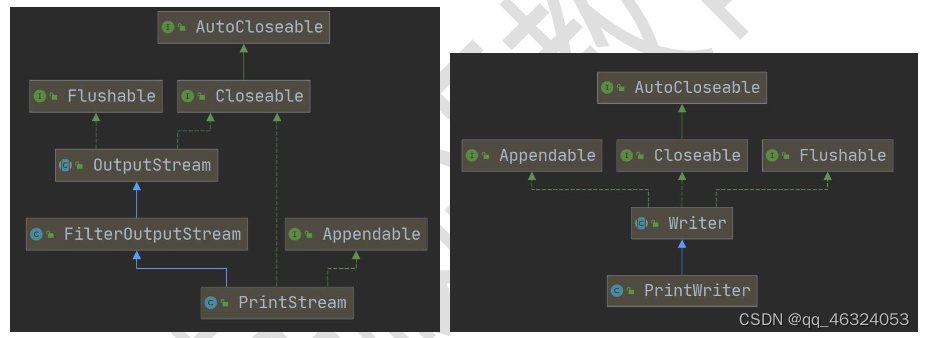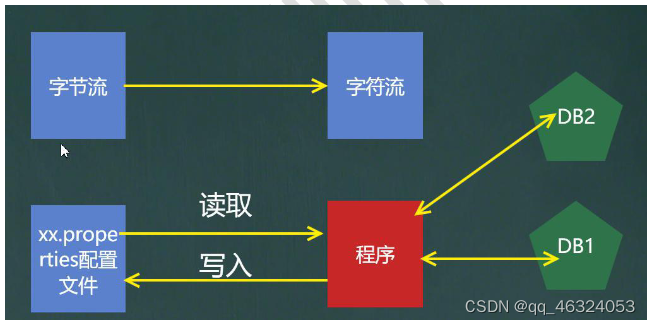JAVA SE -- 第十六天
(全部来自“韩顺平教育”)
IO流
一、文件
是保存数据的地方
2、文件流
文件在程序中是以流的形式来操作

流:数据在数据源(文件)和程序(内存)之间经历的路径
输入流:数据从数据源(文件)到程序(内存)的路径
输出流:数据从程序(内存)到数据源(文件)的路径
二、常用的文件操作
1、创建文件对象相关构造器和方法

举例如下:
//方式 1 new File(String pathname)@Testpublic void create01() {String filePath = "e:\\news1.txt";File file = new File(filePath);try {file.createNewFile();System.out.println("文件创建成功");} catch (IOException e) {e.printStackTrace();}}//方式 2 new File(File parent,String child) //根据父目录文件+子路径构建
//e:\\news2.txt@Testpublic void create02() {File parentFile = new File("e:\\");String fileName = "news2.txt";//这里的 file 对象,在 java 程序中,只是一个对象//只有执行了 createNewFile 方法,才会真正的,在磁盘创建该文件File file = new File(parentFile, fileName);try {file.createNewFile();System.out.println("创建成功~");} catch (IOException e) {e.printStackTrace();}}//方式 3 new File(String parent,String child) //根据父目录+子路径构建@Testpublic void create03() {//String parentPath = "e:\\";String parentPath = "e:\\";String fileName = "news4.txt";File file = new File(parentPath, fileName);try {file.createNewFile();System.out.println("创建成功~");} catch (IOException e) {e.printStackTrace();}}2、获取文件的相关信息
getName、getAbsolutePath、getParent、length、exists、isFile、isDirectory

//获取文件的信息@Testpublic void info() {//先创建文件对象File file = new File("e:\\news1.txt");//调用相应的方法,得到对应信息System.out.println("文件名字=" + file.getName());//getName、getAbsolutePath、getParent、length、exists、isFile、isDirectorySystem.out.println("文件绝对路径=" + file.getAbsolutePath());System.out.println("文件父级目录=" + file.getParent());System.out.println("文件大小(字节)=" + file.length());System.out.println("文件是否存在=" + file.exists());//TSystem.out.println("是不是一个文件=" + file.isFile());//TSystem.out.println("是不是一个目录=" + file.isDirectory());//F}3、目录的操作和文件删除
mkdir创建一级目录、mkdirs创建多级目录、delete删除空目录或文件

三、IO流原理及流的分类
1、Java IO流原理
①I/O是Input/Output的缩写,I/O技术是非常实用的技术,用于处理数据传输。如读/写文件,网络通讯等
②Java程序中,对于数据的输入/输出操作以“流(stream)”的方式进行。
③Java.io包下提供了各种“流”类和接口,用以获取不同种类饿数据,并通过方法输入或输出数据
④输入input:读取外部数据(磁盘、光盘等存储设备的数据)到程序(内存)中
⑤输出output:将程序(内存)数据输出到磁盘、光盘等存储设备中
2、流的分类
①按操作数据单位不同分为:字节流(8bit)二进制文件,字符流(按字符)文本文件
②按数据流的流向不同分为:输入流,输出流
③按流的角色的不同分为:节点流,处理流/包装流
| (抽象基类) | 字节流 | 字符流 |
| 输入流 | InputStream | Reader |
| 输出流 | OutputStream | Writer |
注:Java的IO流共涉及40多个类,实际上非常规则,都是从如上4个抽象基类派生的。由这四个类派生出来的子类名称都是以其父类名作为子类名后缀。
四、IO流体系图--常用的类

1、FileInputStream介绍
使用 FileInputStream 读取 hello.txt 文件,并将文件内容显示到控制台
/**
* 演示读取文件...
* 单个字节的读取,效率比较低
* -> 使用 read(byte[] b)
*/@Testpublic void readFile01() {String filePath = "e:\\hello.txt";int readData = 0;FileInputStream fileInputStream = null;try {//创建 FileInputStream 对象,用于读取 文件fileInputStream = new FileInputStream(filePath);//从该输入流读取一个字节的数据。 如果没有输入可用,此方法将阻止。//如果返回-1 , 表示读取完毕while ((readData = fileInputStream.read()) != -1) {System.out.print((char)readData);//转成 char 显示}} catch (IOException e) {e.printStackTrace();} finally {//关闭文件流,释放资源.try {fileInputStream.close();} catch (IOException e) {e.printStackTrace();}}}/**
* 使用 read(byte[] b) 读取文件,提高效率
*/@Testpublic void readFile02() {String filePath = "e:\\hello.txt";//字节数组byte[] buf = new byte[8]; //一次读取 8 个字节.int readLen = 0;FileInputStream fileInputStream = null;try {//创建 FileInputStream 对象,用于读取 文件fileInputStream = new FileInputStream(filePath);//从该输入流读取最多 b.length 字节的数据到字节数组。 此方法将阻塞,直到某些输入可用。//如果返回-1 , 表示读取完毕//如果读取正常, 返回实际读取的字节数while ((readLen = fileInputStream.read(buf)) != -1) {System.out.print(new String(buf, 0, readLen));//显示}} catch (IOException e) {e.printStackTrace();} finally {//关闭文件流,释放资源.try {fileInputStream.close();} catch (IOException e) {e.printStackTrace();}}}2、FileOutPutStream介绍
使用 FileOutputStream 在 a.txt 文件,中写入 “hello,world”. , 如果文件不存在,会创建
文件(注意:前提是目录已经存在.)
/**
* 演示使用 FileOutputStream 将数据写到文件中,
* 如果该文件不存在,则创建该文件
*/@Testpublic void writeFile() {//创建 FileOutputStream 对象String filePath = "e:\\a.txt";FileOutputStream fileOutputStream = null;try {//得到 FileOutputStream 对象 对象//1. new FileOutputStream(filePath) 创建方式,当写入内容是,会覆盖原来的内容//2. new FileOutputStream(filePath, true) 创建方式,当写入内容是,是追加到文件后面fileOutputStream = new FileOutputStream(filePath, true);//写入一个字节//fileOutputStream.write('H');////写入字符串String str = "hsp,world!";//str.getBytes() 可以把 字符串-> 字节数组//fileOutputStream.write(str.getBytes());/*write(byte[] b, int off, int len) 将 len 字节从位于偏移量 off 的指定字节数组写入此文件输出流*/fileOutputStream.write(str.getBytes(), 0, 3);} catch (IOException e) {e.printStackTrace();} finally {try {fileOutputStream.close();} catch (IOException e) {e.printStackTrace();}}}
3、FileReader和FileWriter
①FileReader相关方法:

②FileWriter常用方法

③举例:
//1) 使用 FileReader 从 story.txt 读取内容,并显示/*** 单个字符读取文件*/@Testpublic void readFile01() {String filePath = "e:\\story.txt";FileReader fileReader = null;int data = 0;//1. 创建 FileReader 对象try {fileReader = new FileReader(filePath);//循环读取 使用 read, 单个字符读取while ((data = fileReader.read()) != -1) {System.out.print((char) data);}} catch (IOException e) {e.printStackTrace();} finally {try {if (fileReader != null) {fileReader.close();}} catch (IOException e) {e.printStackTrace();}}}/*** 字符数组读取文件*/@Testpublic void readFile02() {System.out.println("~~~readFile02 ~~~");String filePath = "e:\\story.txt";FileReader fileReader = null;int readLen = 0;char[] buf = new char[8];//1. 创建 FileReader 对象try {fileReader = new FileReader(filePath);//循环读取 使用 read(buf), 返回的是实际读取到的字符数//如果返回-1, 说明到文件结束while ((readLen = fileReader.read(buf)) != -1) {System.out.print(new String(buf, 0, readLen));}} catch (IOException e) {e.printStackTrace();} finally {try {if (fileReader != null) {fileReader.close();}} catch (IOException e) {e.printStackTrace();}}}//2) 使用 FileWriter 将 “风雨之后,定见彩虹” 写入到 note.txt 文件中, 注意细节.public class FileWriter_ {public static void main(String[] args) {String filePath = "e:\\note.txt";//创建 FileWriter 对象FileWriter fileWriter = null;char[] chars = {'a', 'b', 'c'};try {fileWriter = new FileWriter(filePath);//默认是覆盖写入// 3) write(int):写入单个字符fileWriter.write('H');// 4) write(char[]):写入指定数组fileWriter.write(chars);// 5) write(char[],off,len):写入指定数组的指定部分fileWriter.write("韩顺平教育".toCharArray(), 0, 3);// 6) write(string):写入整个字符串fileWriter.write(" 你好北京~");fileWriter.write("风雨之后,定见彩虹");// 7) write(string,off,len):写入字符串的指定部分fileWriter.write("上海天津", 0, 2);//在数据量大的情况下,可以使用循环操作.} catch (IOException e) {e.printStackTrace();} finally {//对应 FileWriter , 一定要关闭流,或者 flush 才能真正的把数据写入到文件try {//fileWriter.flush();//关闭文件流,等价 flush() + 关闭fileWriter.close();} catch (IOException e) {e.printStackTrace();}}}}五、节点流和处理流
1、基本介绍
①节点流可以从一个特定的数据源读写数据,如FileReader、FileWriter

②处理流(也叫包装流)是“连接”在已存在的流(节点流或处理流)之上,为程序提供更为强大的读写功能,也更加灵活,如BufferedReader、BufferedWriter

2、节点流和处理流一览图

3、节点流和处理流的区别和联系
①节点流是底层流/低级流,直接跟数据源相接
②处理流(包装流)包装节点流,既可以消除不同节点流的实现差异,也可以提供更方便的方法来完成输入输出
③处理流(也叫包装流)对节点流进行包装,使用了 修饰器设计模式,不会直接与数据源相连
4、处理流的功能主要体现在以下两个方面:
①性能的提高:主要以增加缓冲的方式来提高输入输出的效率
②操作的便捷:处理流可能提供了一系列便捷的方法来一次输入输出大批量的数据,使用更加灵活方便
5、处理流--BufferedReader和BufferedWriter
BufferedReader和BufferedWriter属于字符流,是按照字符来读取数据的,关闭时处理流,只需要关闭外层流即可。
public class BufferedReader_ {public static void main(String[] args) throws Exception {String filePath = "e:\\a.java";//创建 bufferedReaderBufferedReader bufferedReader = new BufferedReader(new FileReader(filePath));//读取String line; //按行读取, 效率高//说明//1. bufferedReader.readLine() 是按行读取文件//2. 当返回 null 时,表示文件读取完毕while ((line = bufferedReader.readLine()) != null) {System.out.println(line);}//关闭流, 这里注意,只需要关闭 BufferedReader ,因为底层会自动的去关闭节点流//FileReader。bufferedReader.close();}
}public class BufferedWriter_ {public static void main(String[] args) throws IOException {String filePath = "e:\\ok.txt";//创建 BufferedWriter//说明://1. new FileWriter(filePath, true) 表示以追加的方式写入//2. new FileWriter(filePath) , 表示以覆盖的方式写入BufferedWriter bufferedWriter = new BufferedWriter(new FileWriter(filePath));bufferedWriter.write("hello, 韩顺平教育!");bufferedWriter.newLine();//插入一个和系统相关的换行bufferedWriter.write("hello2, 韩顺平教育!");bufferedWriter.newLine();bufferedWriter.write("hello3, 韩顺平教育!");bufferedWriter.newLine();//说明:关闭外层流即可 , 传入的 new FileWriter(filePath) ,会在底层关闭bufferedWriter.close();}
}6、处理流--BufferedInputStream和BufferedOutputStream


public class BufferedCopy02 {public static void main(String[] args) {String srcFilePath = "e:\\a.java";String destFilePath = "e:\\a3.java";//创建 BufferedOutputStream 对象 BufferedInputStream 对象BufferedInputStream bis = null;BufferedOutputStream bos = null;try {//因为 FileInputStream 是 InputStream 子类bis = new BufferedInputStream(new FileInputStream(srcFilePath));bos = new BufferedOutputStream(new FileOutputStream(destFilePath));//循环的读取文件,并写入到 destFilePathbyte[] buff = new byte[1024];int readLen = 0;//当返回 -1 时,就表示文件读取完毕while ((readLen = bis.read(buff)) != -1) {bos.write(buff, 0, readLen);}System.out.println("文件拷贝完毕~~~");} catch (IOException e) {e.printStackTrace();} finally {//关闭流 , 关闭外层的处理流即可,底层会去关闭节点流try {if(bis != null) {bis.close();}if(bos != null) {bos.close();}} catch (IOException e) {e.printStackTrace();}}}
}7、对象流--ObjectInputStream和ObjectOutputStream
序列化和反序列化
①序列化就是在保存数据时,保存数据的值和数据类型
②反序列化就是在恢复数据时,恢复数据的值和数据类型
③需要让某个对象支持序列化机制,则必须让其类是可序列化的,为了让某个类是可序列化的,该类必须实现如下两个接口之一:
Serializable //这是一个标记接口,没有方法
Externalizable //该接口有方法需要实现,建议使用上面的接口
①对象流介绍
功能:提供了对基本类型或对象类型的序列化和反序列化的方法
ObjectOutputStream:提供序列化功能
ObjectInputStream:提供反序列化功能

②案例1:使用 ObjectOutputStream序列化基本数据类型和一个Dog对象(name,age),并保存到data.dat文件中
public class ObjectOutStream_ {public static void main(String[] args) throws Exception {//序列化后,保存的文件格式,不是存文本,而是按照他的格式来保存String filePath = "e:\\data.dat";ObjectOutputStream oos = new ObjectOutputStream(new FileOutputStream(filePath));//序列化数据到 e:\data.datoos.writeInt(100);// int -> Integer (实现了 Serializable)oos.writeBoolean(true);// boolean -> Boolean (实现了 Serializable)oos.writeChar('a');// char -> Character (实现了 Serializable)oos.writeDouble(9.5);// double -> Double (实现了 Serializable)oos.writeUTF("韩顺平教育");//String//保存一个 dog 对象oos.writeObject(new Dog("旺财", 10, "日本", "白色"));oos.close();System.out.println("数据保存完毕(序列化形式)");}
}③案例2:使用ObjectInputStream读取data.dat并反序列化恢复数据
// 1.创建流对象
ObjectInputStream ois = new ObjectInputStream(new FileInputStream("src\\data.dat"));
// 2.读取, 注意顺序
System.out.println(ois.readInt());
System.out.println(ois.readBoolean());
System.out.println(ois.readChar());
System.out.println(ois.readDouble());
System.out.println(ois.readUTF());
System.out.println(ois.readObject());
System.out.println(ois.readObject());
System.out.println(ois.readObject());
// 3.关闭
ois.close();
System.out.println("以反序列化的方式读取(恢复)ok~");④注意事项
a.读写顺序要一致
b.要求序列化或反序列化对象,需要实现Serializable
c.序列化的类中建议添加SerialVersionUID,为了提高版本的兼容性
d.序列化对象时,默认将里面所有属性都进行序列化,但除了static或transient修饰的成员
e.序列化对象时,要求里面属性的类型也需要实现序列化接口
f.序列化具备可继承性。也就是如果某类已经实现了序列化,则它的所有子类也已经默认实现了序列化
8、标准输入输出流
| 类型 | 默认设备 | |
| System.in标准输入 | InputStream | 键盘 |
| System.out标准输出 | PrintStream | 显示器 |
9、转换流--InputStreamReader和OutputStreamWriter
①基本介绍
a.InputStreamReader:Reader的子类,可以将InputStream(字节流)包装成(转换)Reader(字符流)
b.OutputStreamWriter:Writer的子类,实现将OutputStream(字节流)包装成Writer(字符流)
c.当处理纯文本数据时,如果使用字符流效率更高,并且可以有效解决中文问题,所以建议将字节流转换成字符流
d.可以在使用时指定编码格式(比如utf-8,gbk,gb2312,ISO8859-1等)
②例子1:将FileInputStream包装成(转换成)字符流InputStreamReader,对文件进行读取(按照utf-8/gbk格式),进而在包装成BufferedReader
public class InputStreamReader_ {public static void main(String[] args) throws IOException {String filePath = "e:\\a.txt";//解读//1. 把 FileInputStream 转成 InputStreamReader//2. 指定编码 gbk//InputStreamReader isr = new InputStreamReader(new FileInputStream(filePath), "gbk");//3. 把 InputStreamReader 传入 BufferedReader//BufferedReader br = new BufferedReader(isr);//将 2 和 3 合在一起BufferedReader br = new BufferedReader(new InputStreamReader(new FileInputStream(filePath), "gbk"));//4. 读取String s = br.readLine();System.out.println("读取内容=" + s);//5. 关闭外层流br.close();}
}③例子2:将FileOutputStream包装成(转换成)字符流OutputStreamWriter,对文件进行写入(按照gbk格式)
// 1.创建流对象
OutputStreamWriter osw =
new OutputStreamWriter(new FileOutputStream("d:\\a.txt"), "gbk");
// 2.写入
osw.write("hello,韩顺平教育~");
// 3.关闭
osw.close();
System.out.println("保存成功~");10、打印流--PrintStream和PrintWriter
打印流只有输出流,没有输入流

六、Properties类

public class Properties01 {public static void main(String[] args) throws IOException {//读取 mysql.properties 文件,并得到 ip, user 和 pwdBufferedReader br = new BufferedReader(new FileReader("src\\mysql.properties"));String line = "";while ((line = br.readLine()) != null) { //循环读取String[] split = line.split("=");//如果我们要求指定的 ip 值if("ip".equals(split[0])) {System.out.println(split[0] + "值是: " + split[1]);}}br.close();}
}1、基本介绍
①专门用于读写配置文件的集合类
配置文件的格式:
键=值
②注意:键值对不需要有空格,值不需要用引号一起来,默认类型是String
③Properties的常见方法
2、应用案例1:使用Properties类完成对mysql.properties的读取
public class Properties02 {public static void main(String[] args) throws IOException {//使用 Properties 类来读取 mysql.properties 文件//1. 创建 Properties 对象Properties properties = new Properties();//2. 加载指定配置文件properties.load(new FileReader("src\\mysql.properties"));//3. 把 k-v 显示控制台properties.list(System.out);//4. 根据 key 获取对应的值String user = properties.getProperty("user");String pwd = properties.getProperty("pwd");System.out.println("用户名=" + user);System.out.println("密码是=" + pwd);}
}3、应用案例2:使用Properties类添加key-val到新文件mysql2.properties中
public class Properties03 {public static void main(String[] args) throws IOException {//使用 Properties 类来创建 配置文件, 修改配置文件内容Properties properties = new Properties();//创建//1.如果该文件没有 key 就是创建//2.如果该文件有 key ,就是修改properties.setProperty("charset", "utf8");properties.setProperty("user", "汤姆");//注意保存时,是中文的 unicode 码值properties.setProperty("pwd", "888888");//将 k-v 存储文件中即可properties.store(new FileOutputStream("src\\mysql2.properties"), null);System.out.println("保存配置文件成功~");}
}
